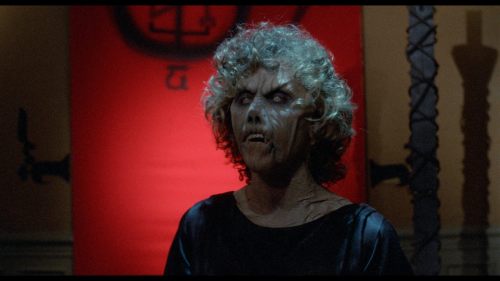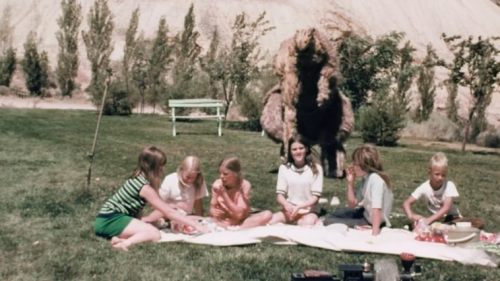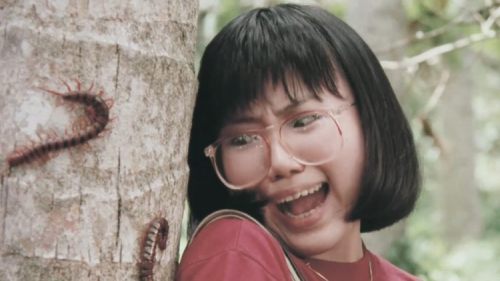Everybody’s Into Weirdness: DAY OF THE DEAD (1985)
The Alamo Drafthouse is a brand built on weird. Beyond being situated in a town that has long aspired to remain eccentric in the face of all normality, it’s easy to forget that the original Alamo started as something of a private screening club, running prints of the odd and obscure into all hours of the night*. Though the company has obviously grown into an internationally recognized chain of first run movie palaces, the Drafthouse Ritz in Austin, Texas remains committed to showcasing genre repertory programming, namely via its Terror Tuesday and Weird Wednesday showcases. This column is a concentrated effort to keep that spirit of strangeness alive, as programmers Joe A. Ziemba and Laird Jimenez (often pulling from the extensive AGFA archives) are truly doing Satan’s bidding by bringing ATX weekly doses of delightful trash art.
The tenth entry into this disreputable canon is George Romero’s underrated final film in his original “Living Dead Trilogy,” Day of the Dead…
Year: 1985
Trailer: Monkey Shines
(Two Terror Tuesdays in a row! To celebrate the thirtieth birthday of George Romero’s Day of the Dead, it only felt right to revisit it via this rare 35mm screening. But don’t worry…we’ll return to regularly scheduled Weirdness next week…promise.)
When Mario Bava’s Blood and Black Lace made its way to American shores, the New York Times labeled it a "wanton waste." “Gore films” (a grouping Bava’s elegant 1964 masterwork would unfortunately be lumped in with) were scoffed at and overlooked by the '60s critical community. Horror was in a transitional phase, moving away from Hitchcockian mysteries and Universal Monsters – evolving with extra-textual cultural influences (Vietnam, the Summer of Love, the Civil Rights Movement). Guts were initially viewed as a growing pain, as critics weren’t entirely prepped to process such brazen shock tactics.
It wouldn’t be until 1968 that a slice of grisly horror would grab the zeitgeist, as a tiny black and white picture (made in Pittsburgh of all places) started to screen at drive-ins, reaping positive reviews and a growing cult of admirers. Featuring an African American actor (Duane Jones) fighting off a mass of flesh-hungry ghouls who had risen from their graves, the film was as radical as it was ribald. Capped by an ending in which hick cops unknowingly gun down our hero, the film was viewed as an overt political statement, something the genre was not known for.
George A. Romero’s Night of the Living Dead would go on to be a smash independent success, terrifying the general public while simultaneously influencing a legion of up-and-coming auteurs (John Carpenter saw the film numerous times as a student at USC, while Dario Argento fell madly in love with it during his time as a film critic in Rome). Night was a revelation, momentarily lifting horror out of the cinematic ghetto and introducing the world to a new kind of movie monster — the shambling, cannibal zombie who could only be killed via a bullet straight to the brain.
The beast had been portrayed on the big screen before (see: 1932′s White Zombie for the best example), but a human master almost always controlled it via voodoo. In Night of the Living Dead, the zombies were mindless murderers; a slow moving pestilence governed by nothing and consuming every human who got in their way. Those who weren’t eaten were “turned” with a mere bite, resulting in paralysis, death and demonic resurrection. Stark and brutal, Romero’s picture was a triumph of DIY know-how, cobbled together by a family of creators who transformed their Yinzer hills into the mound on which humanity would take its last stand against Death itself.
Smitten with Romero’s vision, Argento (who had since become a successful filmmaker in his own right, churning out garish, dream logic gialli like Deep Red) reached out to the Steel City auteur. Romero had been struggling post-Night with a string of critically lauded yet commercially unsuccessful pictures such as Martin, an ambiguously icky tale of a serial rapist who may also be an ancient vampire. Argento proposed making a sequel, and the two artists met in New York, where the Italian Hitchcock pitched an offer to help him find funding for the follow-up overseas. Knowing he needed a hit to keep his career afloat, Romero accepted.
Argento flew Romero out to Rome and set him up with an apartment, where the director wrote his second “Dead” film, Dawn of the Dead, in five weeks, with the Italian pulp maestro acting as a “script consultant.” When the movie was released, Argento cut a version for Italy (where it opened first, in September 1978), while Romero was allowed his own edit for the US (which runs almost ten minutes longer and has a completely recued soundtrack). Both were a resounding success, as Dawn of the Dead doubled its meager production budget ($650,000) in a mere five weeks, and then grew legs when it came to American shores in April 1979, despite the fact that it was slapped with an ‘X’ rating by the MPAA (which the producers quickly did away with, notoriously releasing the film as ‘Unrated’).
Dawn showcased another political subtext, playfully jabbing American consumerism while completely changing the tone of the series. Where Night was a black and white, nihilistic nightmare, Dawn sported the popping primary palette of Argento’s best work, with over-the-top gore effects by a young, former Vietnam photographer (Tom Savini). Zombies would become incredibly popular in Italian horror immediately after, as Lucio Fulci and Umberto Lenzi crafted their own schlock masterpieces that were heavily indebted to Dawn.
Even critics ate up Romero’s sequel, as Roger Ebert, who had been wildly dismissive of the original film, noted that Dawn was:
…brilliantly crafted, funny, droll, and savagely merciless in its satiric view of the American consumer society. Nobody ever said art had to be in good taste.
There it was — a mainstream publication hailing a gory genre film as legitimate art, as opposed to a "wanton waste." Romero had won, despite the fact that he saw the political subtext as nothing more than a “pie in the face” gag. While the director surely enjoyed the praise, he couldn’t believe that people fell for his blood-splattered, Technicolor laugh.
Following the global financial success of Dawn, it’d seemingly be a no-brainer for Romero to pursue making another installment in his zombie franchise. Only instead he inked a three-picture deal with United Film Distribution Company (under the stipulation that one of the three be a sequel to Dawn) and directed Knightriders – an extremely personal non-horror film he knew wouldn’t have gotten bankrolled otherwise. After that unfortunate financial failure, Romero helmed Creepshow, his first collaboration with Stephen King. Inspired by the EC Horror Comics of the '50s, the anthology would go on to be a modest box office hit, reaffirming Romero’s status as a somewhat bankable cult director. The only problem is that Warner Bros. (acting as distributor) took the majority of the profits, leaving UFDC with only a minor return on their investment.
At this point, it only seemed logical (not to mention contractually mandated) for Romero to complete the zombie opus that had defined his career thus far. The third film to be financed under the UFDC agreement, Day of the Dead was initially written with a much bigger budget in mind. Romero’s original drafts envisioned an epic end to a series that was already apocalyptic in scope, including numerous zombie battles and a living dead take on H.G. Wells’ The Island of Dr. Moreau, in which a group of scientists are training their own army of the undead. Yet fiscal constraints were implemented when Romero demanded that the film be just as graphic as Dawn (requiring it be released “Unrated,” as its predecessor was), resulting in the director having to pare the screenplay down into a more intimate picture. Gone were tropical islands and swamp shootouts, replaced with a spartan underground bunker, filled with a collection of machismo-spewing military hotheads, ready to add the scientists who worked under their watch to the zombie legion.
Through print publications such as Fangoria, the details of Romero’s original artistic vision had been made public. So when Day of the Dead was originally released in July 1985, it was met with hostility from fans expecting something entirely different from what they got. Instead of humanity’s last bombastic stand against the ghouls that had overrun the planet, Day of the Dead was the horror film equivalent of an existentialist conversation. None of the characters were overly likable, and most of the men who wore the camouflage were pig-headed psychopaths, ready to put an end to reason with a revolver.
Elements of Romero’s original draft remained. The scientists are still attempting to study the dead. Only instead of turning them into weapons, zombie domestication is what Dr. Logan (Richard Liberty) is trying to accomplish; an analysis of what humanity remains in “Bub” (Sherman Howard, inhabiting what may be Savini’s most iconic creation). “Bub” is a zombie who listens to music, salutes the brass and, at one point, fires a gun. One could argue that the underground facility was sort of like an island, quarantining the toiling researchers away. The rest? Shelved completely, as the monetary risk of an “Unrated” picture was too great for producer Salah M. Hassanein to grant Romero all of the funds he needed to bring his complete concept to life**.
To put Day of the Dead into a greater context, 1985 was the same year that would see Rambo become a Reagan-era icon, with First Blood Part II raking in nearly $150 million in ticket sales. American audiences weren’t in the mood to see those same soldiers painted as misogynistic miscreants, commanded by a rabid insane person (Joe Pilato, who was reportedly so full-tilt in his performance that the rest of the cast were afraid of him). The colorful palette of Dawn was also nowhere to be found, replaced by drab greys, browns and greens — all engulfed in dark shadow. It’s easy to understand why not only the public, but also horror fans rejected the film. When the punk rock “unofficial sequel,” Return of the Living Dead, grossed $14 million at the US box office, while Day only raked in $6 million, the proof was in the receipts. Even Roger Ebert reverted back to his anti-zombie stance, saying that Romero should "quit while he’s ahead."
However, while Romero’s third vision of the future may be his most dour, Day of the Dead is possibly the most thematically impressive of the original trilogy. Though the filmmaker is quick to state that the sociopolitical subtexts of the first two films were mostly inadvertent pulp byproducts, Romero has admitted that the thesis for his third “Dead” film arose out of a distrust of government. Day is concerned with how power structures form and societal pockets are forced to interact with one another, causing friction in a time of crisis. This conflict leads to life structures weakening, and those at the top of the food chain becoming blinded by their own wants in regards to an empathetic course of action. Military might trumps scientific curiosity. Stay the course and keep the status quo, or risk being shot by the man in green.
Both Dawn and Day present the last remnants of humanity as trapped rats. Only in Dawn, these “final few” were folks you legitimately didn’t mind hanging out with for two-plus hours. The four companions in Dawn became a non-traditional familial unit and, at one point, even started getting comfortable with their new life in the Monroeville Mall. This bond renders Dawn’s tragic end that much tougher to take than the onslaught that comes during the third film’s finale. In Day, antagonistic militants and snappish scientists replace the neighborly vibe. It’s a contrast as stark as the two films’ general aesthetics, and makes it easy to understand why some fans initially bristled when faced with the proposition of spending time in this concrete cave.
Romero’s commitment to progressive casting choices remains intact, as he yet again places a strong woman (Lori Cardille) and a black man (Terry Alexander) front and center (just as he’d done with both Night and Dawn). Ditto his love for theater performers, whom he allows to create fully realized human beings within his frame. The set design in the bunker often resembles a stage, with the blocking meticulously mapped out. Every take feels like the twelfth, as the thespians are maxed out; sweaty and screaming at one another as they elbow to have their positions heard. Though they may not be wholly pleasant, the characters’ prickliness is the point, as this is truly all that’s left of the human race (and, in turn, all these humans have left inside of them). Day of the Dead not only chronicles the remaining few, but also the exhaustion of their emotions in service of a battle of ideologies.
Sharing the space with these shattered survivors is Savini’s spectacular splatter. Day of the Dead is the FX maestro’s magnum opus – a culmination of his wizardry up to this point. While the blood in Dawn was cartoonish and pink, here it’s deep crimson and even black, spilling out of split bellies and cracked skulls. Day of the Dead is Savini returning to his war photographer roots, especially during the hideously grotesque climax, during which soldiers are massacred by an invasion of the living dead. Throats are torn, limbs are severed, and intestines are unspooled like reels of fleshy film before being munched. Yet beyond these stomach-turning atrocities, Savini is having fun designing each and every zombie, giving them distinct personalities via flesh wounds. From the opening on, where a jawless freak lurches and leers directly at the audience, it’s clear that Day of the Dead is as much Savini’s franchise victory lap as it is Romero’s.
At one point, John (Alexander), a helicopter pilot who recognizes that lingering in this tomb is the worst mistake the survivors could make, tells Sarah (Cardille) that her efforts to find a solution to the “zombie problem” are futile. She’s “never going to figure it out,” and humanity’s fate was possibly a result of “getting too big for our britches.” In essence, this is the entirety of Day of the Dead encapsulated in one bit of dialogue. God has done His damage, and the only course for the human race to take is finding a way to start over and live instead of foolishly fighting back or attempting to “domesticate” that which cannot be controlled. Only in verbalizing his picture’s thematic through-line with one (admittedly impressive) monologue, Romero has also captured a fundamental truth that stretches beyond his dramatic set-up. At the heart of Day of the Dead lies the question every human being needs to face: how are you going to approach your existence, when death could be knocking on your door at any moment?
*For an oral history of the Drafthouse’s beginnings, I’ll refer you to Zack McGhee’s wonderful “My Favorite Movie” Podcast, where he interviews old school DH programmers Lars Nilsen and Zack Carlson, as well as current Wednesday night ringmaster, Laird Jimenez. They’re GREAT listens, full of knowledge, wit and insight.
**Excised portions of the original draft would also be repurposed for Land of the Dead, twenty years later.
For more excellent reading on Romero and his horror peers, I’d highly recommend Jason Zinoman’s excellent “Shock Value” which, along with Scream Factory’s superlative Day of the Dead Blu-ray, was the primary reference source utilized to write this article.
Tonight on Weird Wednesday: The Kentucky Fried Movie
Previous WW Features: Penitentiary, Skatetown USA; Blood Games; The Last Match; Invasion of the Bee Girls; Julie Darling; Shanty Tramp; Coffy; Lady Terminator



